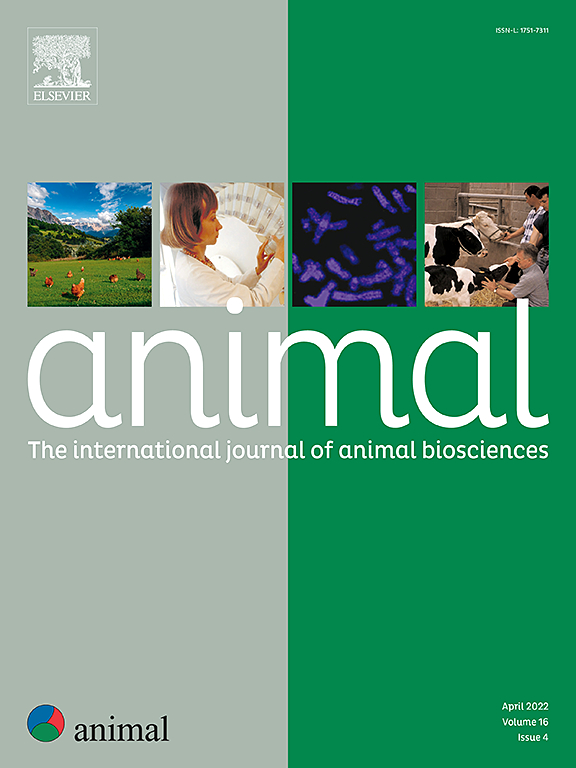发展运动马的温室气体排放模型:盛装舞步和障碍赛的案例研究
IF 4.2
2区 农林科学
Q1 AGRICULTURE, DAIRY & ANIMAL SCIENCE
引用次数: 0
摘要
可持续性在马行业得到越来越多的关注。可持续发展包括各种主题,例如饲料和营养、资源效率、动物福利、碳足迹(CFP)和生物多样性。对马的研究主要集中在行为和福利方面。关于马科动物对环境影响的信息很少。能找到的为数不多的研究主要是关于当地的影响,例如氮淋溶或层理中的氨浓度。关于马的温室气体排放(GHG)知之甚少,尽管温室气体排放是国家清单报告的一部分,但对于不同类型的马却一无所知。因此,本研究旨在建立一个计算运动马温室气体排放的模型。利用开发的模型(Hoofprint),计算了荷兰一匹运动马的CFP,并确定了温室气体热点。该模型是基于生命周期评估方法开发的,其中应用了多种模型和标准。该模型被开发为适用于所有类型的马和各种学科。在计算运动马全生命周期的CFP时,考虑了繁殖、饲养、运动和退役四个主要阶段。重要的是要考虑到前两个阶段;因此,如果不考虑历史,则CFP将是不完整的。作为案例研究,确定了盛装舞步马和跳马的CFP。收集了各阶段的繁殖、饲养、训练水平、饲料产量和采食量数据。结果表明,在不考虑交通因素的情况下,盛装舞步马和跳马的总排放量相差不大。一匹盛装舞步马每年的CFP从4 132到4 334千克二氧化碳当量不等。一匹跳马每年的CFP在4 158 ~ 4 651 kg CO2当量之间变化。当马匹被运输时,CFP分别增加了每匹马每年1 664和68 528 kg CO2当量。表明运输方式,特别是运输方式和距离对运动马的CFP有很大的影响。本研究首次尝试计算荷兰运动马在国际比赛中的CFP。然而,马的部门更加多样化,包括更多的学科和不同类型的院子。为了更好地了解该行业的影响,需要进行更多的研究。本文章由计算机程序翻译,如有差异,请以英文原文为准。
Developing a greenhouse gas emission model for sport horses: case studies in dressage and jumping
Sustainability is gaining growing attention within the equine sector. Sustainability consists of various subjects including feed and nutrition, resource efficiency, animal welfare, carbon footprint (CFP) and biodiversity, for example. Studies in horse research focus mainly on behaviour and welfare. Little information is available about the environmental impact of equids. The few studies that can be found are principally concerned with local impact, such as nitrogen leaching or ammonia concentrations in bedding. Little is known about greenhouse gas emissions (GHG) for horses, although GHG emissions are part of the National Inventory Report, there is nothing known for different types of horses. Therefore, this study aimed to develop a model to calculate the GHG emissions of a sport horse. Using the developed model (Hoofprint), the CFP of a sport horse in the Netherlands was calculated and the GHG hotspots identified. The model was developed based on life cycle assessment approach where various models and standards were applied. The model was developed to be applicable for all types of horses and various disciplines. To calculate the CFP throughout the whole life of a sport horse, four main stages, reproduction, raising, sport and retirement were considered. It is important to take the first two stages into account; hence otherwise, the history is not taken into consideration, and therefore, the CFP would be incomplete. As case studies, the CFP for both a dressage horse and jumping horse was determined. Data were collected on reproduction, raising, level of training and feed production and feed intake in all phases. Results showed that the total emissions of a dressage horse and jumping horse do not differ much when transport is not taken into account. The CFP of a dressage horse varied from 4 132 to 4 334 kg CO2 equivalent per year. The CFP of a jumping horse varied from 4 158 to 4 651 kg CO2 equivalent per year. When the horses are transported, the CFP increases with 1 664 and 68 528 kg CO2 equivalent per horse per year, respectively. Showing that transport and especially the mode of transport and distance have a great impact on the CFP of a sport horse. This study was a first attempt to calculate the CFP of a Dutch sport horse competing internationally. The equine sector, however, is more diverse and consists of more disciplines and different types of yards. More research is needed to create a better understanding of the sector’s impact.
求助全文
通过发布文献求助,成功后即可免费获取论文全文。
去求助
来源期刊

Animal
农林科学-奶制品与动物科学
CiteScore
7.50
自引率
2.80%
发文量
246
审稿时长
3 months
期刊介绍:
Editorial board
animal attracts the best research in animal biology and animal systems from across the spectrum of the agricultural, biomedical, and environmental sciences. It is the central element in an exciting collaboration between the British Society of Animal Science (BSAS), Institut National de la Recherche Agronomique (INRA) and the European Federation of Animal Science (EAAP) and represents a merging of three scientific journals: Animal Science; Animal Research; Reproduction, Nutrition, Development. animal publishes original cutting-edge research, ''hot'' topics and horizon-scanning reviews on animal-related aspects of the life sciences at the molecular, cellular, organ, whole animal and production system levels. The main subject areas include: breeding and genetics; nutrition; physiology and functional biology of systems; behaviour, health and welfare; farming systems, environmental impact and climate change; product quality, human health and well-being. Animal models and papers dealing with the integration of research between these topics and their impact on the environment and people are particularly welcome.
 求助内容:
求助内容: 应助结果提醒方式:
应助结果提醒方式:


